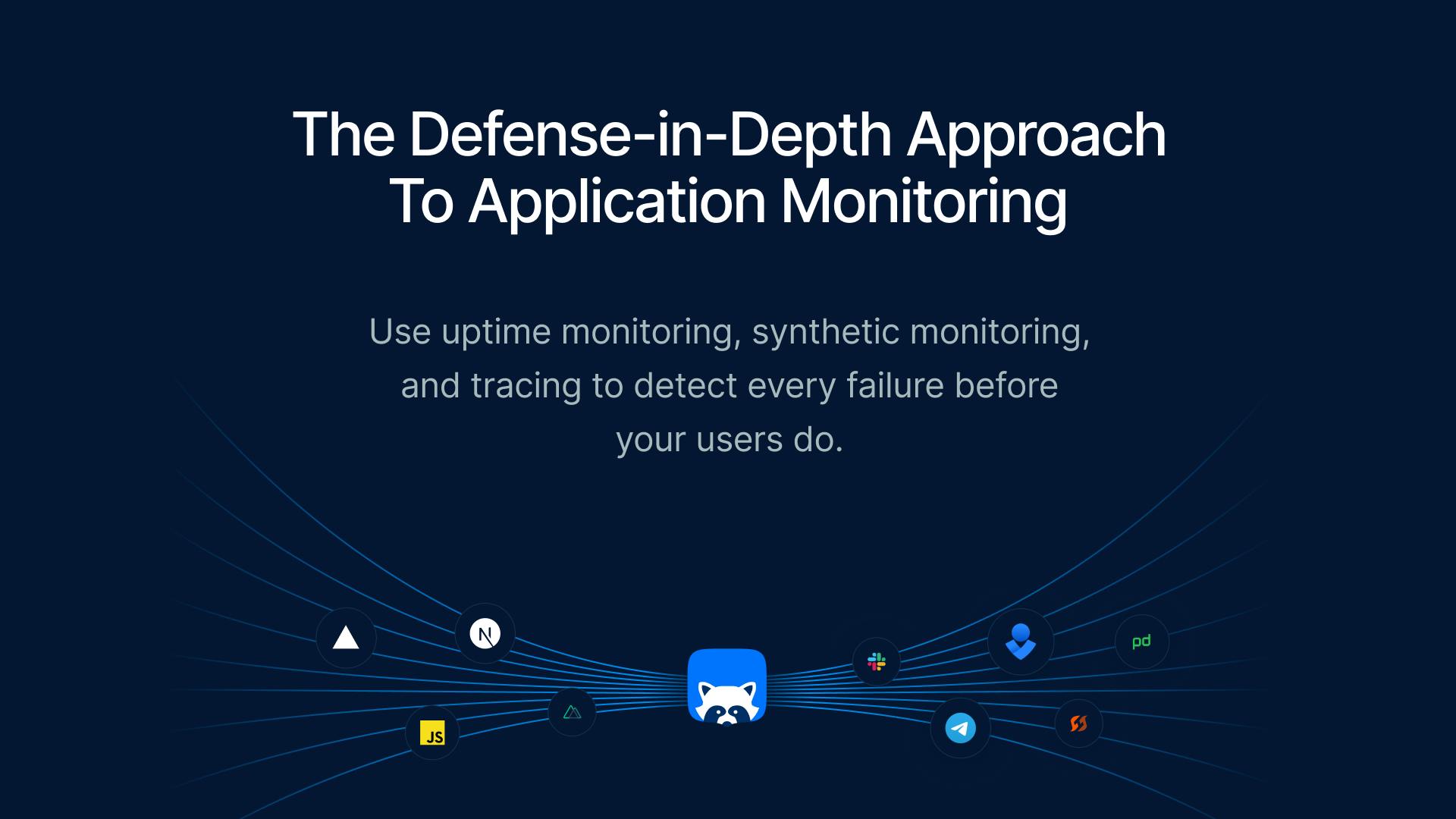Table of contents
In cybersecurity, defense-in-depth is a fundamental principle – you never rely on a single security measure to protect your systems. The same philosophy applies to application monitoring. No single monitoring approach, no matter how sophisticated, can capture every possible failure mode of your application. This is why layered monitoring isn't just a best practice – it's essential risk mitigation.
The Cost of Blind Spots
Every minute your application is down, you're not just losing revenue – you're losing customer trust, damaging your brand, and potentially violating SLAs. According to recent studies, the average cost of downtime ranges from $5,600 per minute for small businesses to over $540,000 per hour for enterprise applications.
But here's the critical insight: different types of failures require different detection methods. A comprehensive monitoring strategy must account for various failure scenarios, each with its own risk profile and detection requirements.
Understanding Your Risk Landscape
Modern applications fail in predictable patterns, each requiring specific monitoring approaches:
Infrastructure Failures (High Frequency, High Impact)
- Risk: Complete service unavailability
- Examples: Server crashes, network outages, DNS failures
- Detection Method: Uptime monitoring
- Recovery Time: Minutes to hours
Application Logic Failures (Medium Frequency, Variable Impact)
- Risk: Broken user workflows despite infrastructure availability
- Examples: Authentication failures, payment processing errors, API integration issues
- Detection Method: Synthetic monitoring with end-to-end testing
- Recovery Time: Hours to days
Performance Degradation (Low Frequency, Cumulative Impact)
- Risk: Gradual user experience erosion leading to churn
- Examples: Slow database queries, memory leaks, third-party service delays
- Detection Method: Deep observability with tracing and metrics
- Recovery Time: Days to weeks
The Monitoring Pyramid: Building Your Defense Layers
Think of your monitoring strategy as a pyramid, with each layer serving a specific purpose in your overall risk mitigation approach:
Foundation Layer: Uptime Monitoring
Purpose: Rapid detection of fundamental availability issues
Uptime monitoring serves as your canary in the coal mine. It answers the most basic but critical question: "Is my service responding?" This layer provides:
- Fastest time to detection for infrastructure failures
- Lowest false positive rate for clear-cut availability issues
- Broadest coverage across all your endpoints and services
- Most cost-effective monitoring for basic availability
Without this foundation, you're flying blind to the most common and impactful failure mode – complete service unavailability.
Application Layer: Synthetic Monitoring
Purpose: Validation of critical user journeys and business processes
The synthetic monitoring layer goes beyond basic availability to ensure your application actually works as intended. It simulates real user behavior to catch issues that uptime monitoring might miss:
- Authentication and authorization flows
- Multi-step business processes (checkout, onboarding, etc.)
- Third-party integrations and dependencies
- Cross-browser and device compatibility
Observability Layer: Tracing and Metrics
Purpose: Deep diagnostic capabilities for complex issues
When issues are detected by the lower layers, both application tracing and internal metrics provide the context needed for rapid resolution:
- Full-stack traces showing exactly where failures occur
- Performance metrics identifying bottlenecks
- Error rates and patterns across different services
- Resource utilization and capacity planning data
The Compound Effect of Layered Monitoring
Each monitoring layer reduces different types of risk, but their combined effect is exponential, not additive. Here's why:
Faster Mean Time to Detection (MTTD)
- Uptime monitoring catches infrastructure failures in seconds
- Synthetic monitoring identifies workflow issues within minutes
- Combined, they eliminate the most common detection delays
Reduced False Positives
- Multiple detection methods provide confirmation and context
- Reduces alert fatigue and improves team response times
- Enables more nuanced alerting strategies
Complete Risk Coverage
- Infrastructure failures: Covered by uptime monitoring
- Application failures: Covered by synthetic monitoring
- Performance issues: Covered by observability tools
- No single point of monitoring failure
Improved Recovery Times
- Faster detection leads to faster response
- Better context enables more targeted fixes, and speeds up your Mean Time To Repair (MTTR)
- Layered alerting ensures the right people are notified
The Risk of Monitoring Monoculture
Relying solely on one monitoring approach creates dangerous blind spots:
Only Uptime Monitoring: You'll catch infrastructure failures but miss broken user journeys. Your checkout process could be completely broken while your health check endpoints return 200 OK.
Only Synthetic Monitoring: You'll catch workflow issues but might miss underlying infrastructure problems. A DNS failure could take down multiple services while your complex end-to-end tests are still queued.
Only Deep Observability: You'll have great diagnostic data but poor proactive detection. By the time performance metrics show degradation, customers may have already experienced issues.
Building Your Layered Strategy
Start with the foundation and build up:
- Establish baseline uptime monitoring for all critical services
- Layer in synthetic monitoring for key user journeys
- Add deep observability for complex diagnostic needs
- Integrate alerting across all layers for unified incident response
Each layer should complement, not duplicate, the others. They should share context and feed into a unified incident response process.
The Bottom Line
Application monitoring isn't about choosing between different approaches – it's about combining them strategically to minimize risk across all failure modes. Uptime monitoring provides the rapid, reliable foundation that catches the most common and impactful issues. Synthetic monitoring adds workflow validation. Deep observability provides diagnostic power.
Together, they create a comprehensive defense system that protects your application, your revenue, and your reputation.
Your users don't care about your monitoring philosophy – they just want your application to work. Layered monitoring ensures it does, no matter how it fails.
